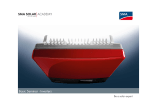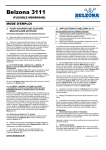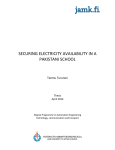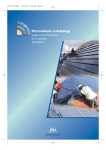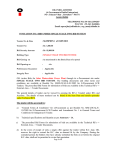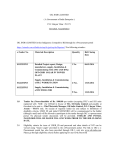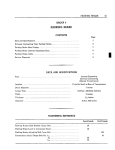Download Solar Consumer guide_Adithyamitra_R0
Transcript
SOLAR POWER Adithyamitra Lights and Solar Solution CONSUMER GUIDE Helping to select thhe e Right Solar power System © 2014 Adithyamitra dithyamitra Lights and Solar Solution – All rights reserved Table of Contents 1. WHY GO SOLAR? ............................................................................................................................ 3 2. TYPES OF SOLAR POWER SYSTEMS .................................................................................................. 4 3. OFF - GRID SYSTEM ......................................................................................................................... 5 4. ON - GRID SYSTEM .......................................................................................................................... 6 5. SOLAR POWER SYSTEM COMPONENTS ........................................................................................... 7 5.1 5.1.1 5.2 5.3 5.4 5.5 Solar panels ............................................................................................................................... 8 Not All Solar Panels are Equal .................................................................................................9 Solar Inverters .......................................................................................................................... 10 Mounting Systems .................................................................................................................... 11 Batteries ................................................................................................................................... 11 Cables and connectors ............................................................................................................. 11 6. SOLAR PANEL INSTALLATION FACTORS ......................................................................................... 12 6.1 6.2 6.3 6.4 Orientation ............................................................................................................................... 12 Tilting ....................................................................................................................................... 12 Shading .................................................................................................................................... 12 Mounting .................................................................................................................................. 12 7. SOLAR POWER SYSTEM LIFESPAN ................................................................................................. 13 8. HOW BIG A SOLAR POWER SYSTEM WILL YOU NEED?.................................................................... 14 9. CHOOSING A SOLAR INSTALLER .................................................................................................... 16 10. KNOW WHAT QUESTIONS TO ASK................................................................................................. 18 11. ADDITIONAL TIPS WHEN SHOPPING FOR SOLAR POWER ............................................................... 19 12. CONCLUSION ................................................................................................................................ 21 2 Solar Power Consumer Guide Version - 1.0 1. WHY GO SOLAR? Solar power systems are collectively saving Indian Indian households over a hundreds of rupees a month on their electricity bills. Aside from giving you the opportunity to generate your own electricity, a roof top solar array addresses issues relating to the expense and inefficiency of distributing power powe over long distances and contributes to reining in wholesale electricity prices in India. • • • • • • The electricity solar panels produce is "clean" - an environmentally friendly, unlike the use of coal or other fossil fuels. No moving parts. emely reliable. Solar modules are extremely Expected life span of several decades. They are also self-cleaning. cleaning. Easy to install and less maintenance. 3 Fig 1.0 Solar Power Consumer Guide Version - 1.0 2. TYPES OF SOLAR POWER SYSTEMS Solar power system can be categorized into two main types SOLAR POWER SYSTEM ON GRID SYSTEM OFF GRID SYSTEM Fig 2.0 • It utilizes large battery banks. • No need of battery banks. • Reduces EB bill. • Reduces EB bill • Uninterrupted power supply. • Reduces diesel (fuel) cost. • Application range 1 – 10kVA • Application > 10kVA • Bit expensive compared to “ON • Cheaper compared to “OFF grid” grid” • Effective usage of generated • power. Storage losses are involved. • Less space sp compared to off grid 4 Solar Power Consumer Guide Version - 1.0 3. OFF - GRID SYSTEM OFF -Grid systems are suitable for people in remote areas, were • • • Main power grid is not available Frequent power cut areas Were back up of power is really required. These systems supply solar generated electricity through an inverter with built in charge controller, which regulates the charging of batteries for energy storage. Fig 3.0 1. Solar panels directly convert sunlight into direct current (DC) electrical energy. 2. DC electricity flows via the charge controller (part of inverter) which regulates the charging of batteries for energy storage. 3. The control board controls DC and AC power and houses the switching and circuit production devices. 4. The inverter converts the DC power into 230V alternating current (AC) ready to be used in the home. 5. The battery bank allows you to collect energy during the day and store it until you need to use it. These can be installed either inside the house or in an external battery shed Solar Power Consumer Guide Version - 1.0 5 4. ON - GRID SYSTEM Most people in commercial and utility areas invest in ON - grid connect systems, because: • • • To reduce electricity tariff To reduce diesel consumption for DG set Mandatory SPO obligation as per solar policy 2012 (Tamil Nadu) Electricity from the solar panels is converted into AC supply suitable for domestic appliances via an inverter. Generated power would be utilized for connected load and the surplus power is fed into the mains grid. (Solar policy norms yet to be implemented in India for domestic feed in of power) Fig 4.0 1. Solar panels directly convert sunlight into direct current (DC) electrical energy 2. The inverter converts the solar DC power into 230V/400V alternating current (AC) ready to fed back into the grid or used in your home 3. AC power from the inverter goes through the switch board for use in your home/ commercial buildings. 4. Any surplus electricity being generated simply flows through into the mains grid for use Solar Power Consumer Guide Version - 1.0 6 elsewhere, excess power feed to grid can be exchanged to money per unit (Policy yet to be finalized) 5. The meter records the energy sent to the grid from your solar system as well as the energy consumed from the grid. (Approval from Electricity Board is required) 5. SOLAR POWER SYSTEM COMPONENTS The core components of a grid connect solar power system are the 1. Solar panels 2. Solar Inverter 3. Mounting system 4. Batteries 6. Cables & accessories 7 Fig 5.1 Solar Power Consumer Guide Version - 1.0 5.1 Solar panels Solar panels come in different wattages and sizes. As a rough guide, each solar panel is approximately 1.7 Meters long and 1 Meters wide. A 1kWp solar system requires 10 - 11 m2 for installation There are 2 main types of solar cells used in solar modules as given below, Solar Panels Parameters Crystalline Thin Film Amorphous Cadmium Telluride Poly Mono 13 - 16% 15 - 19% 6 - 11% 9 - 11% 4 to 5 acres 4 to 5 acres 6 to 7 acres 6 to 7 acres at >25°C; - 0.45% decrease for each increasing °C at >25°C; - 0.42% decrease for each increasing °C at >25°C; - 0.25% decrease for each increasing °C at >25°C; - 0.25% decrease for each increasing °C Proven Proven Recently developed Recently developed Market Share High High Low Low Insurance Yes Yes no no Project Cost Less Slightly higher than poly High compared to crystalline High compared to crystalline Efficiency Space Requirement (1 MW installation) Temperature co efficient (Pmax) Technology Choosing a solar panel on price alone is not wise, as it may not be suited to the area where you wish to install it, it may not have the necessary certifications to qualify for government incentives, or provide the performance required to assist economic payback. What influences the cost of a solar panel? • • • • • • Output capacity Efficiency Physical size Brand Durability Warranty period & certifications Solar Power Consumer Guide Version - 1.0 8 5.1.1 Not All Solar Panels are Equal When Choosing a Solar Panel, it is important to consider both how it is manufactured and what materials are used. There are three tiers of manufacturer’s quality, 9 Fig 5.1.1 Solar Power Consumer Guide Version - 1.0 5.2 Solar Inverters 1. The inverter converts DC power into the AC electricity needed to supply power for standard appliances. 2. As is the case with solar panels, not all solar inverters are equal and inverter efficiency will have a direct impact on the amount of time it takes for a system to pay for itself 3. Obviously, the more efficient the inverter the better - as less electricity will be wasted as heat during the conversion from DC to AC. 4. While the inverter efficiency claimed by a manufacturer may be high, in reality it may not be. The only way to be sure you're buying quality is if the inverter has real world examples of the performance of their equipment, validated by independent third party testing. E.g.(UL, TÜV, etc.,) Inverter is selected based on the application from the above chart 10 Fig 5.2 Solar Power Consumer Guide Version - 1.0 5.3 Mounting Systems The mounting system is a crucial component of a solar array as it will be subjected to major environmental stresses, such as wind. Unfortunately, some suppliers skip on this item. Ensure you ask about quality and material used, • • • • • Hot Dip galvanized, Above 80 microns Corrosion resistant Withstands 150 Km/hr wind speed Tilt angle based on location • Tamil Nadu - > 10° to 15 ° Make : Custom made by manufacturer Fig 5.3 5.4 Batteries OFF grid solar system uses batteries as a power storage device. Based on the application batteries are selected. For Domestic consumers uses, C10 Ratted; Tall tubular – Lead acid Batteries For other rigid and other application, VRLA batteries are used Fig 5.4 Batteries to suit inverter are either added serial or in parallel or both in order to increase or decreases the backup time of power storage. 5.5 Cables and connectors The use of sub-standard connectors and cables can significantly impact on system performance and to fire and electrocution risk. Cabling should be certified to any standard certifying body and solar connectors to EN/IEC 50521 standards. 11 DC Cable MC4 Connectors Fig 5.5 Solar Power Consumer Guide Version - 1.0 6. SOLAR PANEL INSTALLATION FACTORS An accredited solar installer will make sure that solar panels are positioned on your roof for maximum efficiency, safety and correctly wired to the inverter. In terms of panel installation, some considerations that need to be taken into account include orientation, tilting, shading and mounting. 6.1 Orientation As India is in the Northern Hemisphere, in most situations solar panels should be facing as close to true south as possible. However, southwest or west-southwest can be optimal if most of your power is consumed in the afternoon and if you live in a state where the feed in tariff incentive rate is less than the market rate for electricity. 6.2 Tilting S Fig 6.1 Depending on your location, the angle of the solar panels should be between 10° and 32° for best performance on average over a year. For example, 10° is optimal for Chennai location. While tilting angle is an important factor, it is generally as important as the orientation of the panels. 6.3 Shading Fig 6.2 PV panels should ideally be in full sun from at least 7 am to 4pm. They should not be placed in shaded areas and should be kept free from dust and dirt. Shading from objects such as trees, roof ventilators or antennas will have a large impact on the output of a panel, as it changes the flow of electricity through the panel 6.4 Mounting Fig 6.3 The mounting system should be engineer certified for the area you are in. Choosing of right solar mounting system for your project will depend on a few factors. Cost, availability, wind, snow load and seismic activity factors for your area are all considerations. There are two types of mounting system one is Roof mounting and another one ground mounting. 12 Fig 6.4 Solar Power Consumer Guide Version - 1.0 7. SOLAR POWER SYSTEM LIFESPAN Solar modules have been tested in the field showing small reductions in power output after few years, mostly because the glass surface becomes a bit dull and does not absorb as much light. Good solar panels usually carry an output warranty of 25 years. The electronic components such as inverters, being the next most sensitive after panel, should last at least 2 to 5 years before requiring refurbishing or replacement. Solar Panels Product Warranty : 10 Years; Power Warranty : 25 Years Inverter 2 Years (Off Grid); 5 years (On Grid) Batteries 3 – 5 Years ; Warranty at customers DOD and loading of batteries DOD – Dept of Discharge Fig 7.0 13 Solar Power Consumer Guide Version - 1.0 8. HOW BIG A SOLAR POWER SYSTEM WILL YOU NEED? The size of the solar power system you should install depends on: • • • • The physical un shaded area available; typically 1kWp requires around 11sq.m/80sq.fts of space The amount of electricity you wish to generate Connected load Your budget Any size solar power system will reduce your yearly power consumption and your power bill. The bigger the system, the larger the benefit. The output of a solar system depends on its rated capacity, how and where it is installed. The most common household systems are 1 kilowatt, although some people choose to install systems of up to 5 kilowatts. Energy efficiency To make the most of solar power, the key is to implement simple energy efficiency strategies. It is easy to conserve energy by using appropriate lighting and efficient appliances, which can substantially reduce the size of the solar power system you'll need. 14 Solar Power Consumer Guide Version - 1.0 15 Fig 8.0 Solar Power Consumer Guide Version - 1.0 9. CHOOSING A SOLAR INSTALLER As mentioned, in order to be eligible for government subsidies, your system must be installed by suitably qualified installers. An accredited designer/installer will provide you with a solar power system design and specification that includes consideration of your current electricity loads, the type of panels and inverter to be used and panel orientation. Quotations and contracts According to the MNRE, a full system quotation should provide specifications, quantity, size, capacity and output for the major components, including: • • • • • • • • • • • Solar panels Mounting system Inverter Batteries (if applicable) Any additional metering Data-logging devices if specified Travel and transport requirements Other equipment needed Any trench digging if required Installation and commissioning A system user manual. The full quotation should also specify a total price, together with other relevant information. This final quotation document should form the basis of your contract with the designer/installer. The final quotation and accompanying terms and conditions should also include: • • • • • • • • • Average daily electricity output estimate in kilowatt hours An estimated annual production figure of solar system. Estimated output during the most and least favorable months The responsibilities of the installer and customer, including payment obligations Warranty and guarantee details. Who is responsible for connecting the solar panel system to the mains grid (if applicable) The party responsible for meter in case of ON - Grid changeover The party responsible for submitting documentation for feed in tariff incentives How STCs (Standard Test Conditions) will be handled Solar Power Consumer Guide Version - 1.0 16 Fig 9.0 Installation of Solar system at Vellore – 2 kWp (Off Grid) 17 Solar Power Consumer Guide Version - 1.0 10. KNOW WHAT QUESTIONS TO ASK Solar is a substantial investment and it's important you arm yourself with all the facts. Guides assist in helping you make the right decision, but there are also some questions you should ask. I. Questions for your installer 1. Are they an accredited installer? Ask them for their accreditation number. 2. You can also check this at their web site 3. Ask how many systems the company has installed. 4. Does the company have customers, who can provide testimonials or feedback on the quality of their work?? 5. Do the products they use meet Indian/IEC standards and approved by a reputed certifying body? II. Questions for your electricity retailer 1. Will I be moved to ON and OFF peak power usage? 2. What will my ON and OFF peak electricity tariff be? 3. Are there any other costs involved in being a solar customer? 4. What feed in tariff do you offer in case of ON grid? 5. What is the backup time of my batteries? 6. What are all the components available with the package? III. Questions for your electricity provider about the meter connection 1. Which distribution company will be changing my meter? 2. What kind of meter will I be changed to if I go solar? 3. How much will it cost? 4. How long will it take to change my meter over? 18 Solar Power Consumer Guide Version - 1.0 11. ADDITIONAL TIPS WHEN SHOPPING FOR SOLAR POWER 1. Recommendations Ask friends, family, neighbors or colleagues who have had solar systems installed. They'll be able to tell you about their experiences and perhaps alert you to any problems they experienced - ones that you'll be able to avoid. 2. Reject artifice Everyone loves a bonus, but when too much emphasis is placed on a bonus rather than the core product - the solar power system itself - it should be cause for concern. Bear in mind that most gadgets and bonuses included with solar power packages have cost the vendor far less than the retail value they put upon them. Unless the bonus is directly related to the solar power system, you'll be better off forsaking the bonus and negotiating a cheaper price on the system. 3. Have realistic price expectations If you are paying substantially less than many other similar size systems quoted, you may be provided with poor quality equipment and/or poor installation work. Quality equipment and installation isn't cheap and, like all other purchases, you often get what you pay for. Compare components and warranty periods and carry out checks into the company providing the installation. While large, well established companies can pass on substantial savings due to increased buying power, other companies often reduce costs by cutting corners - to the customer's detriment. 4. Solar panel certifications This applies to all solar panel purchases, but especially to the purchases that could attract a government incentive. The certification on solar panels indicates the type of testing that has been done on them. For instance, IEC 61215 confirms that the solar panels have been tested by an independent laboratory and have met their advertised specifications. Other certification types are often self-assessed and so rely on the company being honest in what it claims. 5. More on Panel Types It used to be the case that if you had limited roof space you would need highly efficient and expensive mono-crystalline solar panels. This has rapidly changed with advances in polycrystalline panel technology and some thin film technologies. Even if you have ample roof space you may still want to consider panel sizes vs. output as filling up your roof with inefficient panels will affect your ability to add more panels at a later date, and does not maximize the power output of the space. Solar Power Consumer Guide Version - 1.0 19 It's also important to bear in mind that regardless of claims, no solar panel technology will produce a significant amount of power in full shade and even partial shade may have a substantial impact. 6. Compare all components Compare solar panels, inverters - everything. Package deals are a great way to save cash, but not all packages are created equal. For example, a company might use top quality solar panels, but skimp on inverter, cabling and mounting system quality in the hope that the panel brand name will dazzle you and you'll ignore the other components 7. Beware of hidden costs A low advertised price mightn't be just due to low quality components. While it's not unusual for prices to vary based on the type of structure upon which a solar power system is placed, any extra costs should be clear and not buried in fine print. 8. Get a few Solar Quotes It always wise to gather a few solar quotes when making a major purchase as you will find that prices vary widely between providers. Don't be swayed by price only as inferior components can be used to reduce the up-front cost of the system - but they may wind up costing you more in the long run in terms of reliability and efficiency. 9. Avoid High Pressure Sales People High pressure sales tactics are unfortunately common in the solar industry. Try not to make decisions on the spot - asks the person to let you consider the offer. If it's as good as they claim it will still be a good deal tomorrow. Pressured decisions on the spot often turn out to be less advantageous in reflection. Also ask the sales person whether they offer a cooling off period if you do sign there and then this will give you time to carefully consider your purchase in a less high pressure environment. If you cancel your order within the cooling off period you should ensure that you get a full refund of your deposit. 10. Installation Timelines Solar fever sweeps the nation in waves and during these times providers can become backlogged. While you can expect a wait of up to a few months for a solar installer to perform your installation in some circumstances, this is something you should be made aware of by the system provider. 20 Solar Power Consumer Guide Version - 1.0 11. Warranties and guarantees The durability or longevity of a solar panel is important for a number of reasons - for example, it can be an indicator of the manufacturer's confidence in its products. Reputable solar panels will have product warranty of 10 years and performance warranty a period of 25 years. Yingli and REC Solar, Dago, Hanwha Solar One, Suntech, Phono Solar, Sanyo will offer the same. However, an important point to remember about any warranty is that it will often only be honored for as long as the company operates. It's another reason to select a well known brand of solar panel rather than an obscure low-cost brand from a company that may disappear overnight. As you most likely won't be able to buy panels directly from the manufacturer, your selection of retailer is also important. Choose a company that is a service agent for solar panel warranty work for the particular manufacturer you select. If you do strike a problem, the turnaround time to a resolution should be much faster. 12. CONCLUSION We understand that purchasing a renewable energy system can be a confusing process and a substantial financial commitment-. You can trust we will provide you with exactly what you need - nothing more or less For the right advice from people truly passionate about solar and helping you save on your electricity costs, call on +91- 96 55 22 23 24 or [email protected] PLEASE FEEL FREE TO FORWARD THIS CONSUMER GUIDE TO YOUR FRIENDS, FAMILY, NEIGHBOURS AND COLLEAGUES. 21 Solar Power Consumer Guide Version - 1.0 Contact us Adithyamitra Lights and Solar Solutions No : 114/1, 100 ft ESI Ring Road Near AVS Concrete, ESI Hosur - 635 109 Tamilnadu, India. Ph: +91- 96 55 22 23 24 [email protected] www.adithyamitralights.com © 2014 Adithyamitra Lights and Solar Solution – All rights reserved Solar Power Consumer Guide Version - 1.0 22























